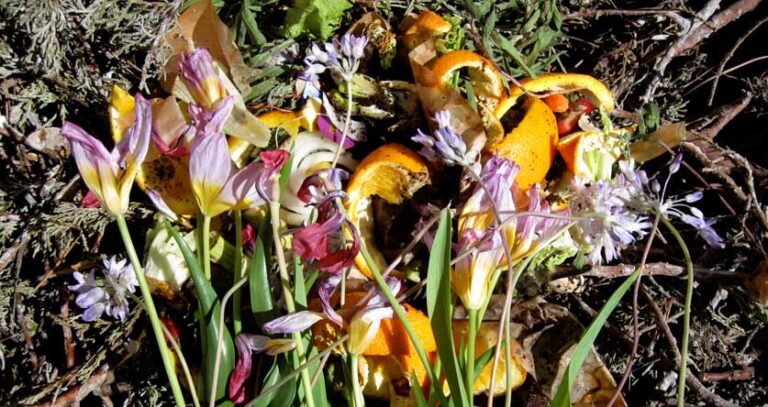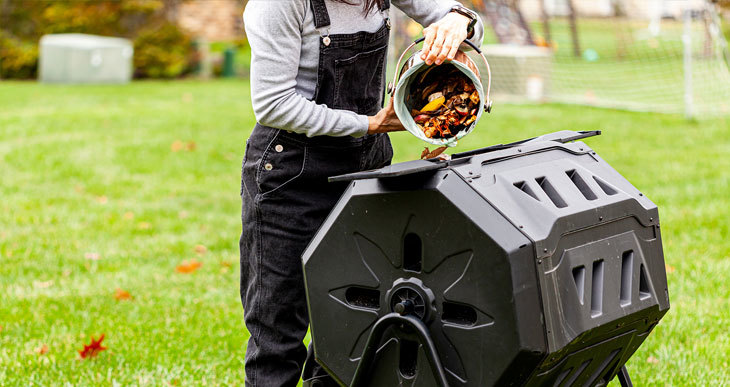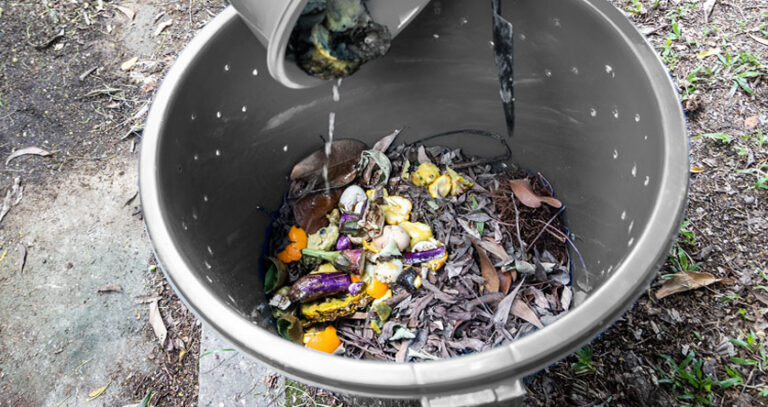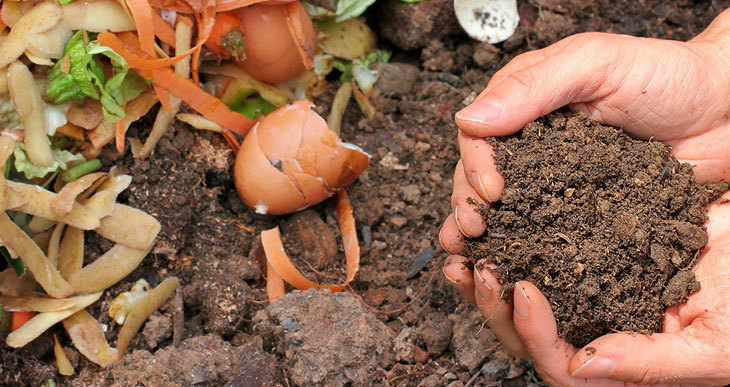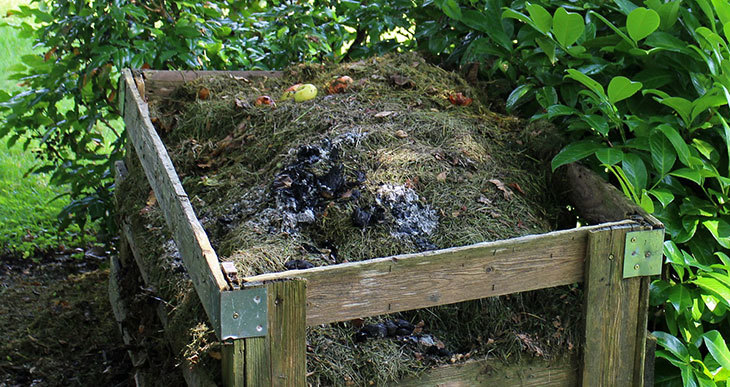Trench Composting (Ultimate Guide to No-Fuss Compost)
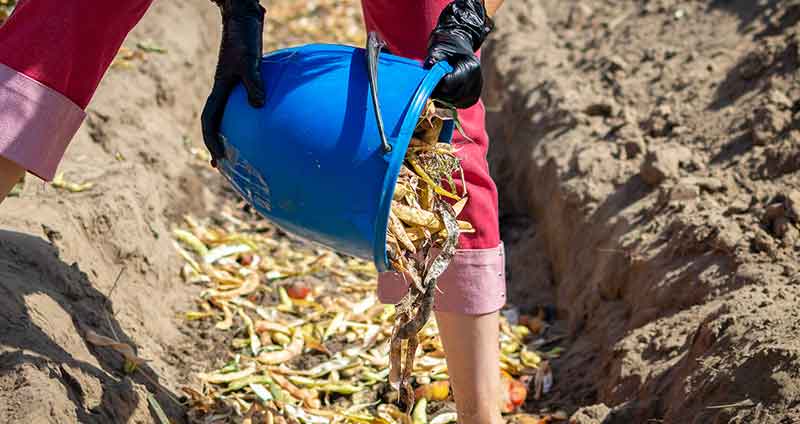
These days we should all be composting! And if you’re conscientious about recycling, you know it needs to be done.
But maybe you’re one of those gardeners who lack space, time, or just don’t like looking after compost heaps!
In that case, you might be missing out on an easy and clean way to compost your waste.
Trench composting is low maintenance, simple, and keeps your compost materials out of sight.
It may be somewhat slower than piles or tumblers, but it works.
Keep reading for the whole shebang!
What is trench composting
Trench composting is an anaerobic method that involves burying organic waste materials underground and letting them decompose. Trench composting is considered an easy method, but the process can be slower, and the compost trench must be left to mature.
So what exactly does trench composting mean?
Trench composting is often cited as the lazy gardener’s method. After all, you don’t have to move your compost once it’s finished. Instead, you just dig a hole, bury your waste, and it remains out of sight until you’re ready to use it.
Trench composting is similar to “pit composting.” The main difference is the shape of your hole. A pit can be any kind of hole you throw your waste into. (Often also called the “dig and drop” method). But a trench is usually more organized and uses long, narrow ditches.
You can think of trench composting as a more systematic way of recycling waste than pit composting. Overall, both these methods are an excellent way to avoid turning your compost by hand and many of the other maintenance issues involved with above-ground compost systems.
But there is one significant caveat!
Trench composting is primarily an anaerobic process. In other words, it happens underground with little or no oxygen. Anaerobic compost includes a few disadvantages, which we’ll discuss below.
Don’t get me wrong!
I’m not trying to put you off “trenching” your compost. On the contrary, there are lots of benefits to this technique. But you do need to be aware of the potential “pitfalls”!
(Get it? “Pit” falls! Ok… I’ll get on with it)
This “generations-old” system is a practical way of recycling organic waste and doing your garden a lot of good!
Let’s take a look at how it all works…
How does trench composting work?
Anaerobic microorganisms decompose the waste materials over several months. Other macroorganisms like earthworms also help the process. The organic-rich materials used for trench composting amend the soil by creating a better structure, thus improving drainage and water retention. The waste materials also make some nutrients to help soil fertility.
This is what happens if you bury kitchen scraps in the garden.
The buried organic materials promote soil life, which has a beneficial effect on plant health. Firstly the microbial activity transforms waste and excretes valuable nutrients. Larger soil life, such as worms, will feed on the waste. Their “poop” is also rich in water-soluble nutrients. The fibrous materials left in the ground after decomposition improve the structure and overall health of the topsoil.
Underground composting like this is very often associated with recycling food scraps. But it is actually better to use a mix of “green” nitrogen-rich scraps and “brown” carbon-rich sources like shredded leaves or other brown materials.
If you only add green material, the process is even slower to decompose than if you mix in some browns.
Trench compost recipe suggestion:
- 1 part kitchen vegetable scraps
- 3 parts dead leaves or other browns
- A layer of alfalfa meal or coffee grounds
The coffee grounds act as a booster to get the process cooking.
Benefits of trench composting
There are many benefits to this technique of producing compost which is why it’s popular with many gardeners, particularly for vegetable gardens that require crop rotation.
Food crops are often grown in rows which is why this method lends itself so well to growing vegetable plants.
The advantages of trench compost include:
- A low-cost way to enrich the soil.
- Low maintenance (no turning).
- No space is needed for a dedicated composter.
- No need to transport finished compost to the site.
- Worms feed off the waste and enrich the soil with their castings.
- Burying compost materials keeps them warmer in cool months and moister in dry summer months.
- Neat “out of sight” method.
Of course, the end result has all of the other benefits of compost. It produces a helpful soil amendment that improves plant health and fertility.
Trench composting disadvantages
Most of the inconveniences associated with trench composting are because of the anaerobic nature of the decomposing waste. There is “some” air initially, but the oxygen supply is quickly used up.
Some of the drawbacks include:
- Slower to decompose (compared to quicker aerobic methods)
- Immature compost can contain pathogens that might transfer to food crops.
- The anaerobic process releases organic acids, which can harm plants.
- The end result is less nutrient-rich compared to aerobic compost.
- Compost materials need covering immediately to avoid attracting pests.
It’s generally recommended to wait one year or the following year’s growing season before planting into compost trenches. Anything sooner involves a few risks.
For a start, growing food crops in raw “garbage” can give humans stomach problems.
Also, the rotting kitchen scraps or other waste imbalances the nutrients in the soil. This happens in the early stages of decomposition. Any high-carbon materials will use up the available nitrogen reserves in the earth. And the nitrogen-rich materials can release nitrogen in the form of ammonia-like substances which contain unavailable ammonia.
This is why this method requires time to properly decompose so that nitrogen is available for plants and to destroy any unpleasant pathogens that can cause stomach problems.
How to trench compost?
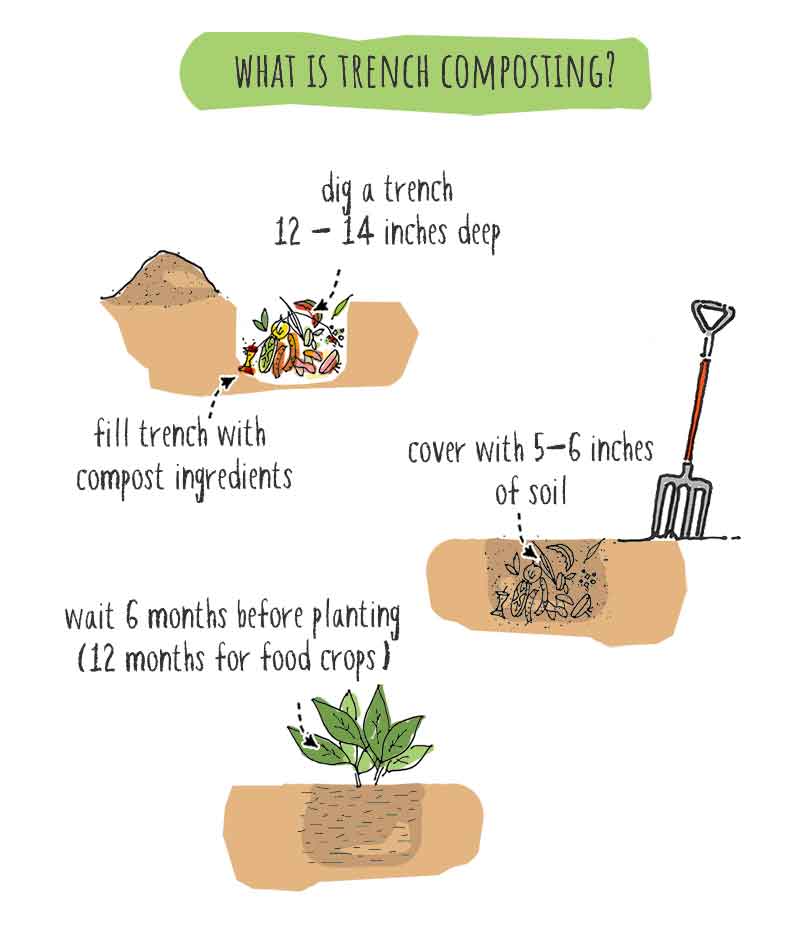
Dig a trench at least 12 to 14 inches deep. Add waste materials until you have 5 or 6 inches of depth left on top. You want enough soil covering for plants to grow after adding waste. Wait 6 months to 1 year before planting on top.
This is the general principle to use whatever type of hole, ditch, or trench.
Trench composting requires a bit of anticipation and planning. First, you need to locate your trenches in the places you will be using for future planting.
Trench compost methods:
Trench and pit composting can be done in different ways. You can even elaborate your own setup, so long as you stick to the general rules.
Some trench methods range from extremely simple, like the “dig and drop” idea, to more sophisticated, such as the rotation method.
Here’s how they work…
Direct trench composting
Direct composting is the term a lot of gardeners use when they talk about standard trench composting. It can be used as a simple composting system when planting rows in your garden beds.
The idea involves two stages:
- During the first season, you plant in one row. In the second row, you dig a trench where you put waste materials.
- In the following season, you invert the process. Plants go in the amended soil where the compost trench was, and the previous season’s planting row becomes the composting trench.
Don’t forget to leave a small footpath between the rows or to one side of the rows.
You can build up the compost trench until complete, then leave it for the next growing season. This leaves several months between burying the compost matter and the following growth season. It also has the advantage of being easy to remember!
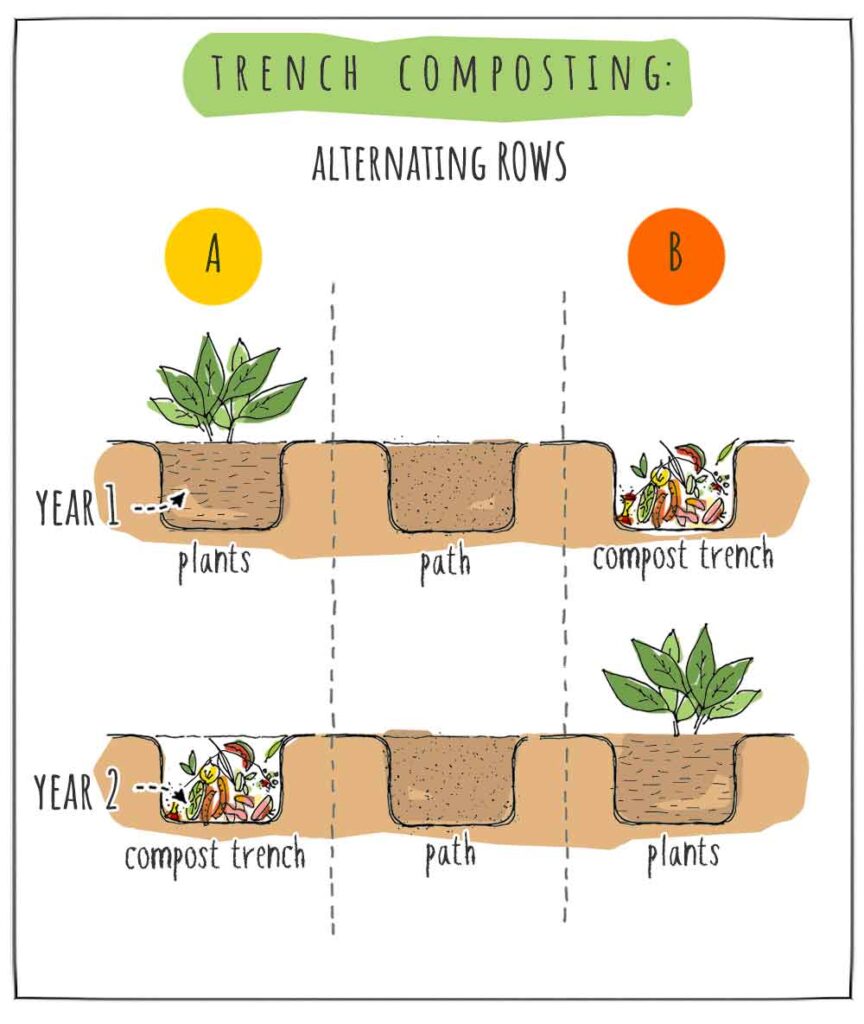
This is a simple “alternating” method of trench composting. Suppose you’re concerned about leaving sufficient time for the compost to break down. In that case, you can try planting crops sequentially in the following order:
- In the first spring, plant above ground vegetables like sweet corn, runner beans, or plants from the squash family.
- Plant deep-rooted veggies like peas and brassica vegetables like broccoli and kale in the following season.
- You could plant in-ground veggies like root vegetables and potatoes in the next cycle.
Trench compost rotation
Perhaps the best way to use trench composting is the rotation method. I’ve also heard this method called “vertical composting” or the “English method”!
It involves laying out your garden into three rows. Each row has a different role for each growing season. A row will change use over a 3-year cycle, so you’re sure that each planted row has well-matured compost and no risks associated with immature rotting waste.
Each row goes through the following cycle of uses:
- Planted row
- Footpath
- Compost trench
The only difficulty is remembering which row served which purpose from one year to another. If you have doubts about doing this, keep notes in a gardening diary, or plant popsicle sticks in each row as a reminder. (Amazon)
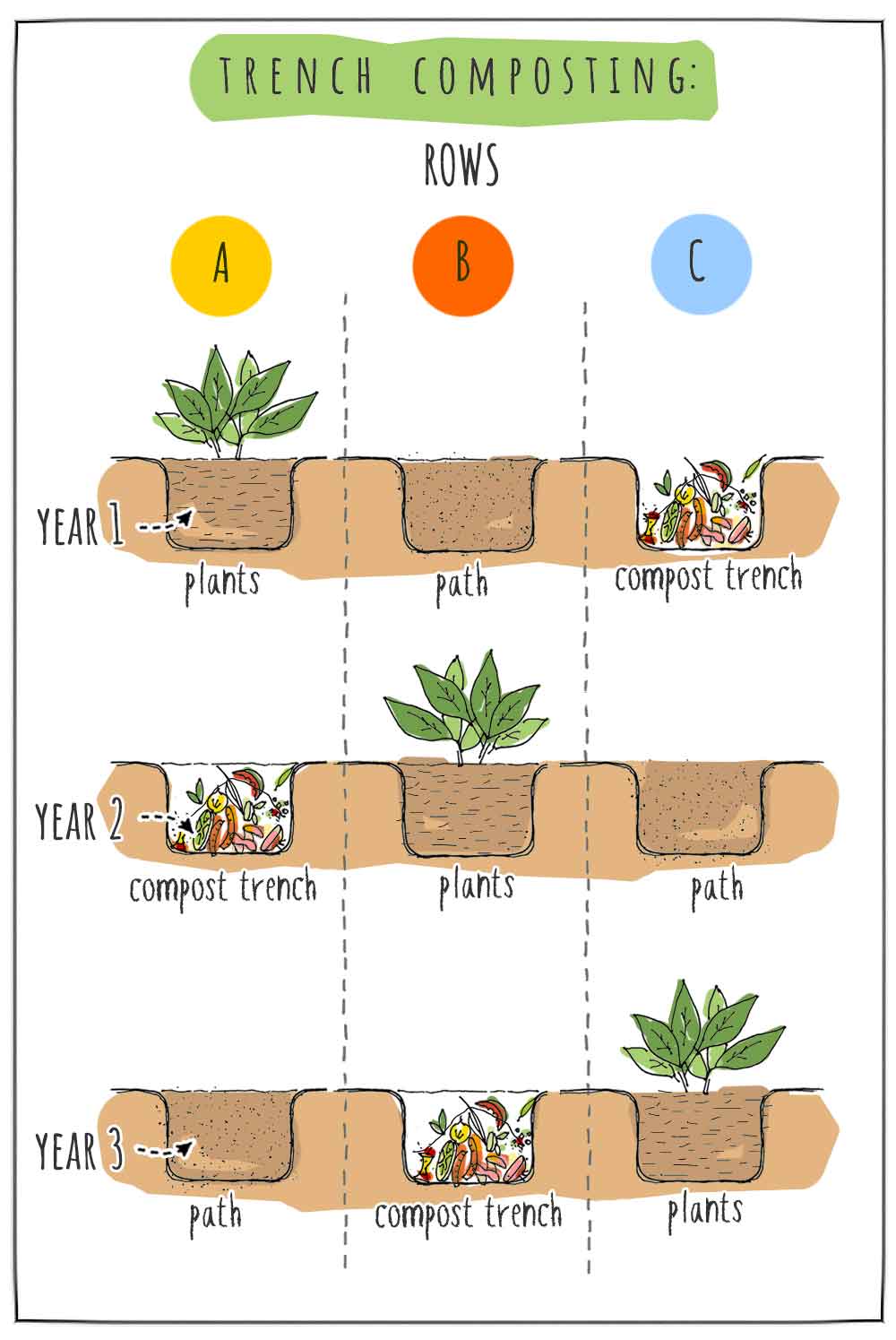
Here’s a summary of how to use the trench composting rotation system.
Divide your space into three rows. Let’s call them rows A, B, and C.
Year 1:
- Row A = plant row
- Row B = walking path
- Row C = compost trench
Year 2:
- Row A = compost trench
- Row B = plant row
- Row C = walking path
Year 3:
- Row A = walking path
- Row B = compost trench
- Row C = plant row
This can be a bit difficult to follow, so use the graphic below to help you visualize the cyclic rotation from year 1 to year 3. The idea is that the planted row moves across the rows from one side to the other (left to right in this view).
After the third year, the cycle begins again, and you revert to the layout in year 1.
Each trench is left unused for two full years before planting (two out of three years, the trench is being used either as a pathway or compost ditch)
Trench composting in raised beds
Trench composting in raised beds can be done using a simple, direct method. You compost into a ditch at the end of the growing season when plants die back. You then have amended soil for the next planting or seeding season.
The beauty of this approach is that you give the proper nutrients back to the soil it was taken from by digging dead plant matter back in.
Let me explain.
Each plant has its own nutritional requirements and will draw those nutrients from the soil during the growing season. A large amount of these nutrients remain locked in the tissues of the dead plants.
By turning those dead plants back into the soil, you can give back some of those nutrients to the earth.
This method also reduces the need to rotate your crops from one year to another and helps soil fertility. So you can continue to plant the same crops on top of the same bed! In the same place, it was grown.
This system has several advantages:
- Nutrients are depleted at a slower rate.
- Lower impact on the soil fertility – less need for fertilizers.
- It also reduces reliance on external sources of compost – more ecological and saves money.
Vegetable plants are annual and die off in the fall or early winter. To prepare the raised beds for the next season, layout one or two trenches for composting:
- Pull up the plants and reserve them for later
- Dig a trench about 12-14 inches deep in the center of the bed, leaving topsoil to one side
- Fill with dead plant waste (shred anything too large)
- Cover it up with the soil.
You should have a mound of soil higher than the original level of the bed. This will flatten as the underlying materials decompose and become more compact. This naturally increases the soil volume, reducing the need to top up your beds.
Your raised garden bed will be ready for planting in the spring.
Deep trench composting
Deep trenches let you compost more significant amounts of materials and ensure you get the finished compost down into the plant’s root layer.
Some gardeners prefer to dig a big wide and deep trench during the whole gardening season.
Here’s how it works:
- Dig a trench 18 to 24 inches deep.
- Each time you add new waste matter, shovel some soil on top. This helps act as a filter for bad smells.
- Add both greens and browns to the mixture.
- Cover the hole when not in use.
The only drawback is the need to cover the trench to avoid attracting pests or rodents to the rotting compost. You can do this with chicken wire or something solid like a plank or an old door!
When to trench compost?
This method is well adapted to annuals, with one growth cycle per growing season. Most vegetables die back in the autumn, making this the most popular time for trench composting.
Pull up dead plants in the fall and add them to new trenches in preparation for the following growing cycle.
What can you add to trench composting
Any kitchen scraps or garden waste can be added to a compost trench. The biggest limiting factor is the volume.
You can only put so much waste in a hole in the ground!
Most gardeners reserve this method for small waste products like fruit and vegetable leftovers. You can also keep a bucket to collect spent flowers and other small garden trimmings to add to the trench.
A mixture of dry brown matter and wet green materials can improve the efficiency of anaerobic, in-ground compost.
Some of the things that make sense to add include:
- Greens: fruit and veg leftovers, grass clippings, coffee grounds, flowers, weeds, feathers.
- Browns: dead leaves, shredded cardboard, newspaper, dead vegetable plants, straw.
Trench composting meat
Any organic substance will decompose given enough time, including meat and fish. Trench composting with meat leftovers is possible with a few caveats.
Bacteria from meat can be harmful, so you want to ensure that everything has decomposed completely before planting food crops near it. Use an organized system that leaves a reasonable space of time before planting.
Also, meat and fish can attract foraging animals. Make sure it is buried deep and that it’s covered over.
Personally, I don’t recommend adding meat or animal products to trench composting.
FAQ
Can I trench compost weeds with seeds?
Weeds that have gone to seed can be trench composted, but they should be buried as deep as possible. Putting weeds and weed seeds underground should reduce their viability considerably. However, you might still get a rogue plant popping up from time to time!
How long does trench composting take
Soft tissue fruit and vegetable matter will break down in a few weeks. Tough fibrous materials like finished corn cobs husks and branchy material will take longer – up to a few months.
Anything you put into a trench composting system will generally break down and be unrecognizable after 6 months. As a rule of thumb, plant on top of compost trenches after 1 year.
If you want trench composting to go faster, you can try combining it with a Bokashi method. Bokashi composting uses a fermentation process to give a boost to waste decomposition. After a few weeks, you have fermented waste called bokashi pre-compost that you can bury.


